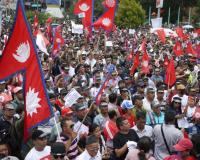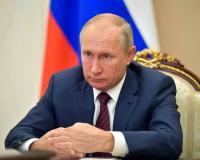- World
- Bipartite talks not military measure can resolve the present crisis with China
Bipartite talks not military measure can resolve the present crisis with China
By Jitendra Nayak & Madhurima Dasgupta Experts feel Asian giants China and India should seek a permanent solution to the present standoff through effective dialogue and not through any military means. In a webinar on “Indo-China Border Issues-The Road Ahead”, organised by the School of Liberal Arts & Culture Studies, Adamas University, Kolkata, the panel

By Jitendra Nayak & Madhurima Dasgupta
Experts feel Asian giants China and India should seek a permanent solution to the present standoff through effective dialogue and not through any military means.
In a webinar on “Indo-China Border Issues-The Road Ahead”, organised by the School of Liberal Arts & Culture Studies, Adamas University, Kolkata, the panel comprising expert a former Indian army general, academicians, research scholars and a journalist, felt that any armed conflict would totally jeopardise the balance in the continent resulting far reaching economic and political consequences. The webinar brought together some of the distinguished speakers from India to focus on the current issues and challenges pertaining to India and China.
The experts felt by openly favouring a direct dialogue with China on the border issue, India has kept its “ally”, the United States, at bay as it does not believe in hyphenation and fiercely guards its strategic independence.
The two countries need to keep their communication channels open as both their bureaucracies and militaries carry a huge historical baggage and cannot think beyond protecting their silos. The direct channel will assume further importance as the succession of the Dalai Lama is on the horizon with China expected to come up with its own candidate as it did in the case of the Panchen Lama. The two most-populated nations in the world, the countries with the first and second largest armies in the world, cannot be adversaries in the new economy as this era “is going to be that of the Asians”.
The experts felt that China’s moves appeared to be in response to India’s road-building activities in the western sector. China has “always been ultrasensitive to India expanding its presence” in the sector. India’s construction of a feeder road was perhaps the first critical trigger — this road connects the LAC near the Galwan River with the DS-DBO road.
The second and perhaps less important trigger is India’s efforts to build a road in Pangong Lake, where India and China dispute the location of the LAC. Chinese moves, especially around Galwan, appear designed to prevent India from completing these road projects, given China’s general weakness at the tactical level in the area. The broader context is the shadow of the 2017 China-India standoff at Doklam on the Chinese-Bhutanese border. India surprised China by deploying troops into territory under Chinese control — but also claimed by Bhutan — to prevent China from extending a track in the area. China viewed the Indian action as a clear violation of its sovereignty.
Although resolved peacefully in September 2017, this standoff greatly heightened Chinese vigilance of Indian activities along the border. By 2019, the number of reported “transgressions” on the border, when Chinese patrols cross into areas where the two sides dispute the LAC, reached their highest levels in a decade if not longer, with the majority occurring in the western sector.
Beginning the discussions, former chief of Staff-Eastern Command, Lt. Gen. John R. Mukherjee said history is proof that the Indo-China relationship has seen many trouble times and even a war. “However, as we cannot choose our neighbors, we have to deal with them pragmatically in the current situation without aligning with any third country”.
Prof. Srikant, Kondapalli, chairperson of the Centre for East Asian studies JNU, New Delhi, said historically Mao-Zedong talked about the military co-existence between India and China and its border issues. “The huge militarization on both side of the border is because of the growing geo-political, strategic issues in the recent times. The possibilities and the policy of disengagement needs to be explored. There is a need to revisit the bilateral relations between India and China refraining from military nationalism. In order to avoid such security dilemmas and quandary, one needs to understand how to responds to such critical situation with tact and far sight”.
Former BBC Journalist, Author and Columnist, Subhir Bhaumik emphasized the fact that when dealing with such a sensitive boarder issues, Indian politicians should refrain themselves from making “popular inciting comments to woo voters and win elections”. He cited an example, as how the current foreign minister, Dr. S. Jaishankar had to visit China as a damage control measure when a political leader made a statement against China. He suggested that “the current situation demands 3 D’s –Disengage, Deescalate and Diffuse”.
Prof. Sriparna Pathak, Assistant Dean at the Jindal School of International Affairs and Fellow at the South Asia Democratic Forum in Brussels, Belgium, said China is responsible for COVID 19 and it was trying all means to emerge as a superpower. “The post covid 19 situation in China has caused immense damage and the country is desperately to rework its economy. The domestic consideration is forcing China to focus on the broader aspects in its pursuance of economic plans in the northern part of OBOR initiative”. And to take the focus off the main objective—the country was causing border issues with India.
Prof.. Rityusha Tiwary, also a visiting fellow at the Institute of Chinese studies, expressed the fact that, the ulterior motive behind the recent boarder dispute is not clearly defined. Considering the current world scenario, a neutral agreement from both the Asian Giants – India and China is the only way out to resolve the current crisis”.
Answering a question from the packed audience, Lt Gen Mukherjee said there is no doubting the capability of the Indian Army and if needed “we will teach them a very good lesson”. But that should be the last option as both the nations had nuclear weapons. “We must realize that a bipartite solution through constant and meaningful dialogue is the best way forward to this long drawn crisis.”
To another question, Bhaumik said the valour of Indian army is unquestionable and “we are more than capable of beating them” but “our political leaders should understand we should act with restrain and responsibility when making statements about the leadership of our neighbouring country, especially when the situation is so sensitive. Also, the country’s leadership must understand that the LAC ground realities are tough and challenging as it passes through ice capped mountains and rivers. This leads the two armies to come close, leading to confrontations.
Referring to a question of the road ahead for the two countries as China was trying to influence countries like Bangladesh and Nepal besides its ally Pakistan, Prof. Kondapalli agreed “if all nations bordering India aligns with China –we will have problems” but cautioned against India immediately aligning with the U.S. “Let us solve the problems through talks”, he added.
The Webinar was moderated by Prof. Mrityunjoy Chatterjee, Dean of School of Liberal Arts & Culture Studies, Adamas University.
ooo











